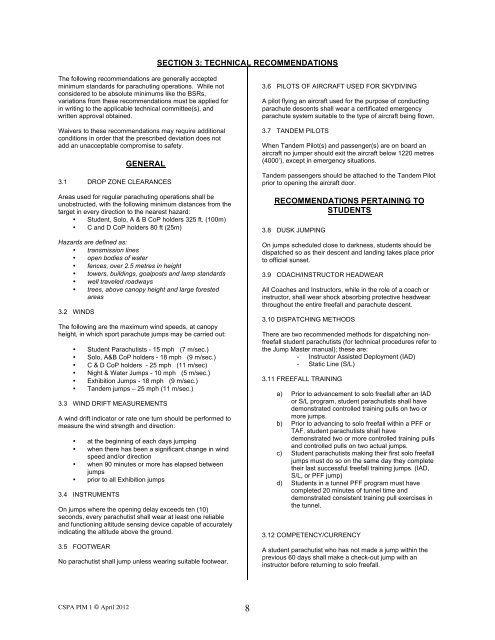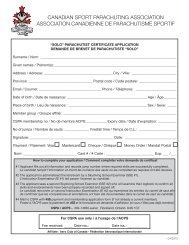PIM 1 2012 Final - Canadian Sport Parachuting Association
PIM 1 2012 Final - Canadian Sport Parachuting Association
PIM 1 2012 Final - Canadian Sport Parachuting Association
You also want an ePaper? Increase the reach of your titles
YUMPU automatically turns print PDFs into web optimized ePapers that Google loves.
The following recommendations are generally accepted<br />
minimum standards for parachuting operations. While not<br />
considered to be absolute minimums like the BSRs,<br />
variations from these recommendations must be applied for<br />
in writing to the applicable technical committee(s), and<br />
written approval obtained.<br />
Waivers to these recommendations may require additional<br />
conditions in order that the prescribed deviation does not<br />
add an unacceptable compromise to safety.<br />
GENERAL<br />
3.1 DROP ZONE CLEARANCES<br />
Areas used for regular parachuting operations shall be<br />
unobstructed, with the following minimum distances from the<br />
target in every direction to the nearest hazard:<br />
• Student, Solo, A & B CoP holders 325 ft. (100m)<br />
• C and D CoP holders 80 ft (25m)<br />
Hazards are defined as:<br />
• transmission lines<br />
• open bodies of water<br />
• fences, over 2.5 metres in height<br />
• towers, buildings, goalposts and lamp standards<br />
• well traveled roadways<br />
• trees, above canopy height and large forested<br />
areas<br />
3.2 WINDS<br />
The following are the maximum wind speeds, at canopy<br />
height, in which sport parachute jumps may be carried out:<br />
• Student Parachutists - 15 mph (7 m/sec.)<br />
• Solo, A&B CoP holders - 18 mph (9 m/sec.)<br />
• C & D CoP holders - 25 mph (11 m/sec)<br />
• Night & Water Jumps - 10 mph (5 m/sec.)<br />
• Exhibition Jumps - 18 mph (9 m/sec.)<br />
• Tandem jumps – 25 mph (11 m/sec.)<br />
3.3 WIND DRIFT MEASUREMENTS<br />
A wind drift indicator or rate one turn should be performed to<br />
measure the wind strength and direction:<br />
• at the beginning of each days jumping<br />
• when there has been a significant change in wind<br />
speed and/or direction<br />
• when 90 minutes or more has elapsed between<br />
jumps<br />
• prior to all Exhibition jumps<br />
3.4 INSTRUMENTS<br />
On jumps where the opening delay exceeds ten (10)<br />
seconds, every parachutist shall wear at least one reliable<br />
and functioning altitude sensing device capable of accurately<br />
indicating the altitude above the ground.<br />
3.5 FOOTWEAR<br />
No parachutist shall jump unless wearing suitable footwear.<br />
SECTION 3: TECHNICAL RECOMMENDATIONS<br />
CSPA <strong>PIM</strong> 1 © April <strong>2012</strong> 8<br />
3.6 PILOTS OF AIRCRAFT USED FOR SKYDIVING<br />
A pilot flying an aircraft used for the purpose of conducting<br />
parachute descents shall wear a certificated emergency<br />
parachute system suitable to the type of aircraft being flown.<br />
3.7 TANDEM PILOTS<br />
When Tandem Pilot(s) and passenger(s) are on board an<br />
aircraft no jumper should exit the aircraft below 1220 metres<br />
(4000’), except in emergency situations.<br />
Tandem passengers should be attached to the Tandem Pilot<br />
prior to opening the aircraft door.<br />
RECOMMENDATIONS PERTAINING TO<br />
STUDENTS<br />
3.8 DUSK JUMPING<br />
On jumps scheduled close to darkness, students should be<br />
dispatched so as their descent and landing takes place prior<br />
to official sunset.<br />
3.9 COACH/INSTRUCTOR HEADWEAR<br />
All Coaches and Instructors, while in the role of a coach or<br />
instructor, shall wear shock absorbing protective headwear<br />
throughout the entire freefall and parachute descent.<br />
3.10 DISPATCHING METHODS<br />
There are two recommended methods for dispatching nonfreefall<br />
student parachutists (for technical procedures refer to<br />
the Jump Master manual); these are:<br />
- Instructor Assisted Deployment (IAD)<br />
- Static Line (S/L)<br />
3.11 FREEFALL TRAINING<br />
a) Prior to advancement to solo freefall after an IAD<br />
or S/L program, student parachutists shall have<br />
demonstrated controlled training pulls on two or<br />
more jumps.<br />
b) Prior to advancing to solo freefall within a PFF or<br />
TAF, student parachutists shall have<br />
demonstrated two or more controlled training pulls<br />
and controlled pulls on two actual jumps.<br />
c) Student parachutists making their first solo freefall<br />
jumps must do so on the same day they complete<br />
their last successful freefall training jumps. (IAD,<br />
S/L, or PFF jump)<br />
d) Students in a tunnel PFF program must have<br />
completed 20 minutes of tunnel time and<br />
demonstrated consistent training pull exercises in<br />
the tunnel.<br />
3.12 COMPETENCY/CURRENCY<br />
A student parachutist who has not made a jump within the<br />
previous 60 days shall make a check-out jump with an<br />
instructor before returning to solo freefall.




